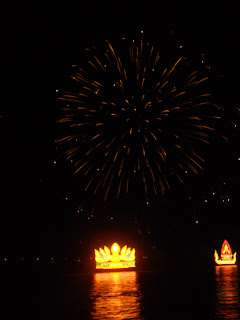In the book I’ve just finished, Tuesdays with Morrie, Morrie talks about the tension of opposites, and how life is run by those tensions. The tension of opposites is exactly what it sounds like: it is the tension we feel between two opposite things. Morrie talks about it in relation to knowing he is going to die, but want to live life to the fullest. Here in Cambodia, I feel that tension everyday: in the classroom, at the apartments, around the city, and especially within myself.
In the classroom, there are moments when I am so happy to be teaching these children, because sometimes, they really understand what I am teaching. I see the instant when their face goes from the confused, what-the-heck-is-she-talking-about face, to the oh-oh-oh-I-get-it face. When I witness that moment, I feel as though what I am doing is not a waste of time, that I might actually be making a difference. Then there are the moments when I think about all the English teachers that have come before me and all the English teachers that will come after me in these student’s lives, and I wonder what I am actually accomplishing. I am here for three months teaching these children. Learning a language takes YEARS, not months, and I think I can really teach these students something they will remember? When I feel this despair, I have to remember that moment of understanding, and remember that even if I can’t teach them everything, I can at least solidify the knowledge they have, and maybe, if there is time, work on something new. I can come up with ideas, and leave them for the next volunteer, so that things aren’t repeated too often, so that we can build on the student’s English foundation. Even if I am only here for a short while, I can do something.
Back at the apartments, I hear the same complaints from the volunteers: They don’t know if what we are doing is worth the time we are giving. Is what we do going to be remembered in the future? Is what we are doing actually appreciated? We want to be giving our time, we want to be helping, but sometimes it feels as though it is pointless, that we should be doing something else, were we can instantly see that we are making a difference. When these questions come up, we all just have to remember that teaching and care is what we came here for, and that whatever we can do is more than what the students and children would get if we were not here.
Within the city, within the country, I see this tension everywhere. I see it in the fact that many things are becoming westernized, that the people all want the lightest skin possible, but there is a fierce national pride. Cambodians love their country and their culture to bits, but at the same time what everything they can from the Western world. It is a hard thing to keep even: retaining the good parts of old ways, but still moving forward into the next phase of life.
And finally, me. I am made from this tension right now, that is it. I have never wanted to be with my family and friends more than at this moment, nor have I ever wanted to stay and experience and help more than right now. It is hard, to have such strong pulls in both directions, and the key is to keep the pulls even. If it isn’t even, then I get homesick, I feel miserable, and I seriously want to find the next flight home and be on it. Each day it is easier to keep the forces even. Each success in the classroom makes it easier, each time a new volunteer arrives it makes it easier, each time I sit down to dinner and hear about the success and troubles of the other volunteers it makes it easier to stay.
It is hard being here, making new friends daily, not know the language, not understanding the customs all the time, not always being able to communicate, not always knowing what I am eating, but each day gets better, each day gets easier, and one of these days, I won’t have to worry about feeling homesick and ready to quit. One day, I won’t want to leave this place.









































